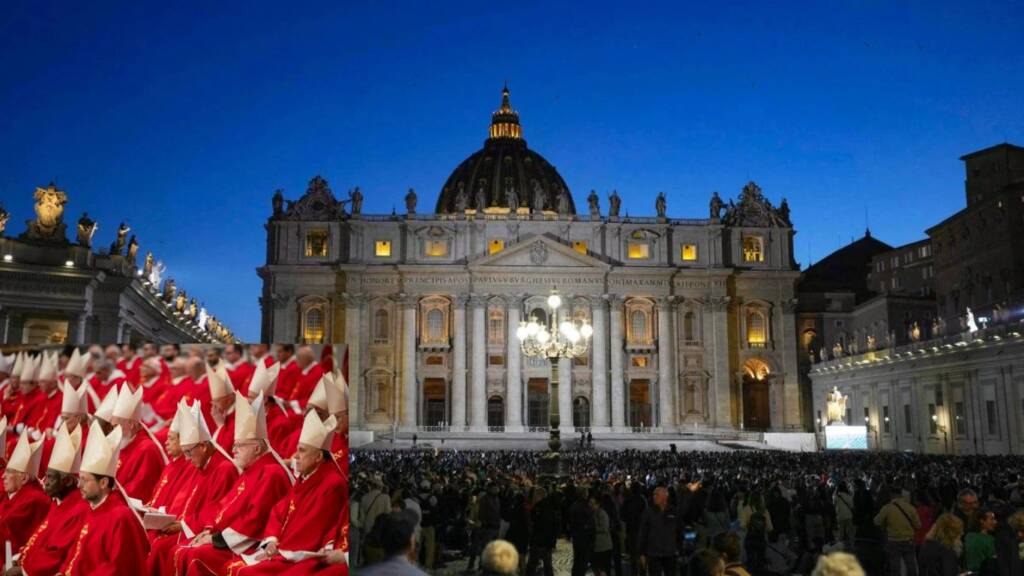Tens of thousands of people have gathered in St. Peter’s Square as Catholic cardinals from all over the world begin the process of choosing a new pope. This comes after the death of Pope Francis on April 21, who served as the leader of the Catholic Church for 12 years. However, black smoke was spotted wafting from the chimney – bringing on a new wave of disappointed reaction in people outside St. Peter’s Square.
The special election process, known as the conclave, started on May 7 inside the famous Sistine Chapel. In line with Church tradition, only cardinals under the age of 80 are allowed to vote. This year, 133 cardinals out of 252 living ones are eligible to vote. To become pope, a candidate must receive at least 89 votes, two-thirds of the total.
The election is secret. The cardinals take an oath not to reveal anything about the process. If anyone breaks the rule, they face the serious punishment of excommunication. Before the voting starts, they gather in the Pauline Chapel for silent prayer and then move to the Sistine Chapel. Once the doors are closed, they are locked in until a decision is made.
No White Smoke Yet
Voting happens up to four times a day. After each round of voting, the ballots are burned. If no pope is elected, black smoke rises from the chimney. If a new pope is chosen, white smoke appears. On the first day, crowds were disappointed when black smoke rose, showing that no decision had been made.
So far, there is no clear favourite. This is the most diverse and international group of cardinal-electors in history, with members from over 70 countries. Many cardinals do not know each other well, which could make agreement harder. For the first time, cardinals from Mongolia, Iran, and East Timor are part of the voting group.
Pope Francis had shaped the current College of Cardinals by appointing more than 80 percent of its members. He was known for promoting diversity and giving more importance to voices from the Global South, especially from Africa, Asia, and Latin America.
Choosing the new pope is not easy. The Catholic Church faces many challenges today, including conflicts around the world, disagreements within the Church, the aftermath of sexual abuse scandals, and falling attendance in churches, especially in Western countries. Many believe that the next pope will need to speak to Catholics in all parts of the world and reflect the growing strength of the Church in Asia and Africa.
Possible Candidates
Several names are being discussed as possible successors to Pope Francis. These include:
- Cardinal Luis Antonio Tagle of the Philippines is known for his kind and progressive views.
- Cardinal Pietro Parolin, the Vatican’s Secretary of State, with strong diplomatic experience.
- Cardinal Peter Turkson of Ghana and Cardinal Fridolin Ambongo Besungu of the Democratic Republic of Congo, both respected African leaders.
- Cardinal Peter Erdo of Hungary, who holds conservative views.
- Cardinal Matteo Zuppi of Italy, known for his peace efforts and social work.
- Cardinal Michael Czerny, a Canadian Jesuit focused on helping the poor.
- Cardinal Pierbattista Pizzaballa, the Latin Patriarch of Jerusalem with deep Middle East experience.
Even though campaigning is not allowed, some cardinals receive more attention than others. But history shows that the elected pope is sometimes someone unexpected. In 2013, Pope Francis surprised many when he was chosen, even though he was not seen as a frontrunner.
Cardinal Giovanni Battista Re, the dean of the College of Cardinals, gave a strong message before the voting began. Although he is too old to vote, he led a special Mass and reminded the cardinals that the world is looking for a leader who can bring unity during these difficult times. He said, “We are here to ask for the Holy Spirit’s help, so that the pope elected will be the one the Church and humanity need now.”
Outside the Vatican, women’s rights groups held peaceful protests. They criticized the fact that no women are allowed to vote or take part in the conclave. One activist, Miriam Duignan, said that the Church cannot keep ignoring half of its followers.
As the conclave continues, the faithful wait in prayer and hope. Many gathered in the square are singing, holding candles, or watching the chimney in silence. The live video feed of the events inside the Vatican is cut off once the voting begins, adding to the mystery of the process.
Until white smoke rises, the world waits for news of who will become the next pope — the 267th leader of the Catholic Church, guiding over 1.4 billion people in faith.
